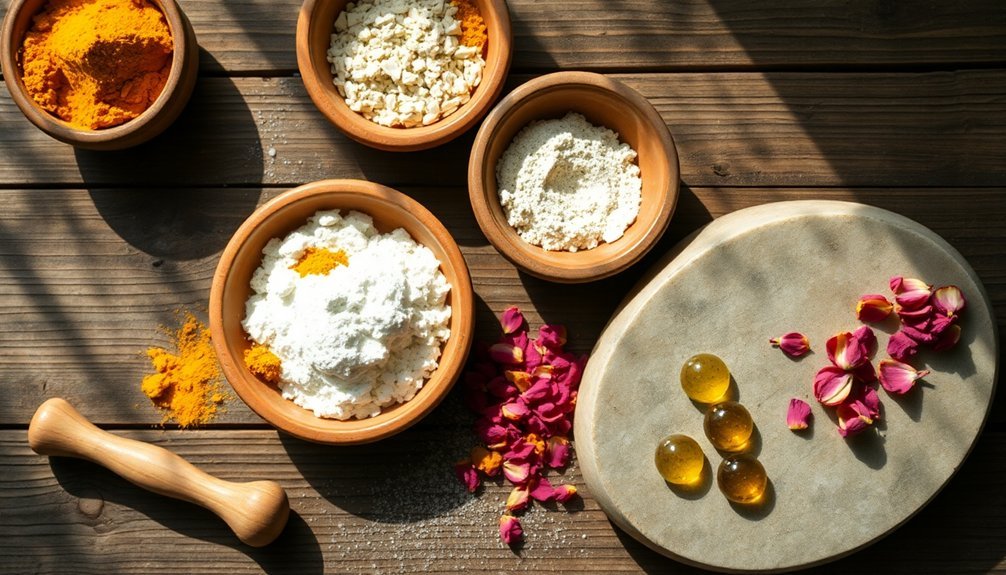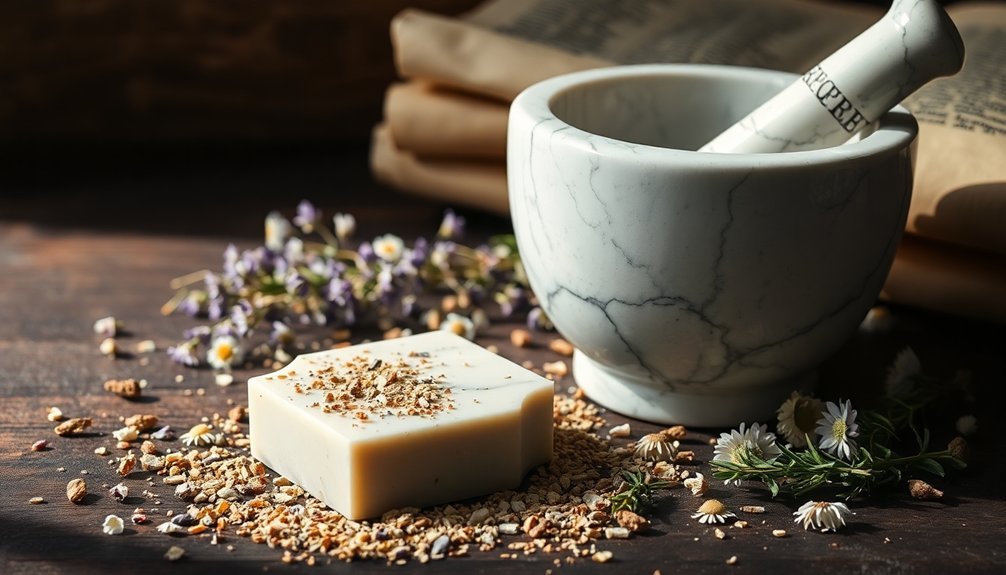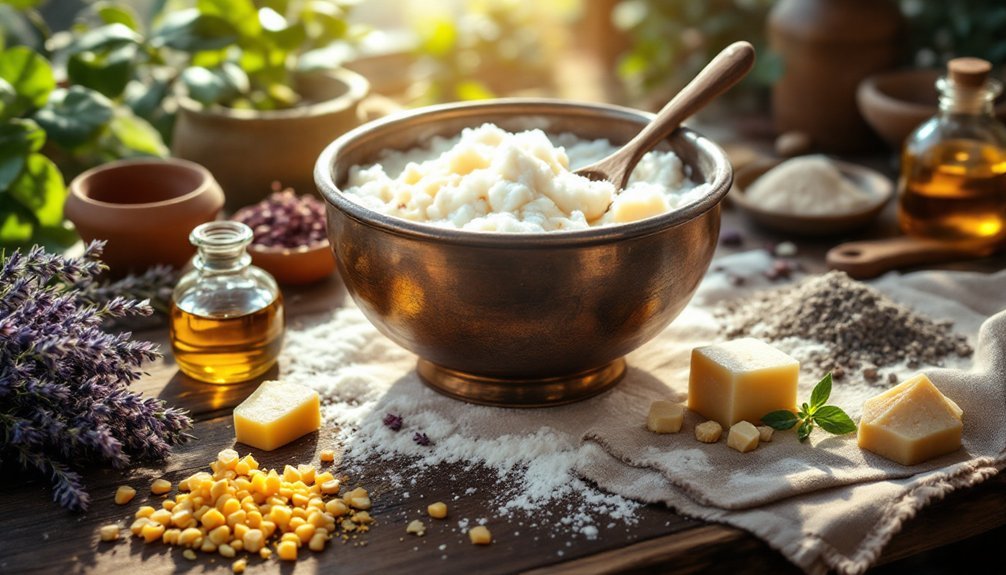Ancient hand-mixing techniques for cleansers combine intention with specific movements. You'll find circular waxing patterns ideal for blending oils with beeswax, while figure-eight motions preserve herbal integrity. Traditional vessels—clay, wood, and stone—enhance your formulation's purity. For authenticity, incorporate botanicals like olive oil, willow bark, and green tea extract. Sustainable practices include repurposing soap scraps and using biodegradable packaging. These time-honored methods reveal a deeper connection to purification rituals that modern synthetics simply can't match.
Sacred Purification Traditions: From Ritual to Everyday Cleansing

Throughout history, humans have sought connection with the divine through purification rituals that transcend mere physical cleanliness.
From ancient Egyptians bathing in the Nile to Greek initiates preparing for the Eleusinian Mysteries, water has served as the primary agent of spiritual transformation.
You'll find these practices across religions worldwide—Christians embrace baptism for rebirth, Hindus bathe in the Ganges before festivals, and Jews observe mikveh rituals before significant life events.
Even marriage preparations incorporated purification, with brides in ancient Rome, Greece, and Jewish traditions undergoing specific cleansing ceremonies.
Today's cleansing routines still echo these ancient practices. Sacred chants and prayers have traditionally accompanied these rituals to purify the mind and elevate the spiritual experience.
When you wash your hands or bathe, you're participating in a tradition thousands of years old—one that continues to provide psychological benefits beyond physical cleanliness.
The Alchemy of Ancient Cleansers: Materials and Ingredients
You'll find ancient cleansing formulations relied on natural abrasives like clay and pumice, which provided texture for effective purification before oils were applied.
The containers that held these sacred mixtures—from Mesopotamian clay vessels to Egyptian alabaster jars—influenced both the preservation and ritualistic significance of the cleansers themselves.
When herbalists incorporated frankincense, olive oil, and local botanicals into these formulations, they created powerful cleansers that balanced physical purification with medicinal properties drawn from nature's pharmacy. Ancient Egyptian manuscripts like the Ebers Papyrus detailed specific recipes that combined vegetable oils with alkaline salts for both hygienic and therapeutic applications.
Natural Abrasives Throughout Time
Long before modern synthetic materials were invented, humans discovered the remarkable cleaning potential of natural abrasives. Ancient Egyptians polished their jewelry and vases using simple materials like sand, seashells, and flexible hide—often attaching these to backings with primitive adhesives.
Throughout history, craftspeople relied on these powerful natural materials for their work:
- Diamond – The hardest natural abrasive, reserved for precision applications
- Corundum – Including rubies and sapphires, prized for durability
- Emery – A mixture of corundum and iron oxide used for grinding
- Garnet – Less abrasive than diamond but effective for polishing
While synthetic alternatives like silicon carbide and alumina now dominate industrial applications, natural abrasives remain relevant in traditional cleansers like Bon Ami, valued for their gentleness and environmental benefits. These natural substances have endured because of their consistent attrition resistance, which determines their effectiveness and longevity during use.
Sacred Vessels' Materials
Ancient civilizations revered the materials used in sacred vessels as much as the vessels themselves, creating a mystical relationship between substance and spirituality.
Gold and silver weren't chosen merely for beauty but for their symbolic purity and divine connection. These metals guaranteed both sanctity and durability across centuries of ritualistic use.
You'll find that linen was preferred for altar cloths and corporals due to its absorbency and symbolic purity.
The materials' alchemical properties transformed ordinary objects into sacred tools through both physical composition and hermetic principles.
When crafting or restoring vessels today, remember that each material carries ritualistic significance beyond its physical properties. Many practitioners incorporate personal cleansing rituals before handling sacred materials to maintain energetic purity.
The white of purificators symbolizes purity, while the metal of chalices, often decorated with vine imagery, embodies permanence and reverence.
Herbalism Meets Purity
When herbalism intertwines with cleansing rituals, a profound alchemy emerges that transcends mere physical purification.
Ancient formulators understood that proper extraction techniques were essential to preserve botanical potency, whether using Chinese Honey Locust rich in natural saponins or sacred Ayurvedic blends.
You'll find these time-honored ingredients still relevant today, though modern extraction methods like super critical fluid extraction have enhanced their effectiveness.
The wisdom of botanical formulation includes:
- Selecting saponin-rich plants like soapnuts as gentle surfactant alternatives
- Incorporating anti-inflammatory botanicals such as mugwort and chamomile
- Using traditional darkening agents like cypress leaf and He Shou Wu
- Blending regional herbal wisdom from Chinese, Ayurvedic, and Middle Eastern traditions
This marriage of ancient botanical knowledge with modern formulation creates cleansers that honor both tradition and effectiveness. Historical records like the Compendium of Materia Medica provide invaluable documentation of these botanical cleansing traditions that continue to influence contemporary natural product development.
Hand-Mixing Techniques From Bygone Eras: Movement and Intention
When crafting ancient-inspired cleansers, you'll want to master circular waxing patterns that Egyptians used to blend oils and beeswax into smooth consistencies.
Incorporate herbal infusion stirring techniques by gently folding dried botanicals into your base using figure-eight motions that distribute ingredients evenly without crushing delicate components.
Try adopting sacred rhythm techniques from traditional soap makers who believed intentional, meditative movements during mixing would imbue cleansers with positive energy and healing properties. Understanding the importance of maintaining your skin's natural pH of 5.5 can guide how you formulate your cleanser to avoid the drying effects common with alkaline commercial soaps.
Circular Waxing Patterns
Traditional circular waxing patterns have long been embedded in popular culture, famously depicted in "The Karate Kid" with its "wax on, wax off" mantra.
While iconic, these motions may actually introduce unwanted marring and swirl patterns to your cleansers and surfaces.
For better results when hand-mixing cleansers, consider these alternatives:
- Use linear front-to-back motions instead of circles to avoid creating uneven patterns
- Apply ZW patterns to effectively cover all angles of your mixing surface
- Maintain consistent pressure with tools like a Polishing Pal for uniform results
- Finish with microfiber materials to guarantee a streak-free outcome
Today's techniques blend historical wisdom with modern refinements, acknowledging that while circular motions have their place, they're not always ideal for achieving the pure, pristine finishes you desire. Applying multiple thin layers of product yields superior results compared to a single thick application.
Herbal Infusion Stirring
Five distinct stirring techniques from ancient herbalists distinguish effective herbal infusions from merely adequate ones. When you're creating infusions, your stirring motion isn't merely mechanical—it's intentional and precise. Ancient cultures believed that proper stirring transferred energy into the mixture while ensuring even distribution of herbal properties.
| Technique | Purpose |
|---|---|
| Spiral motion | Distributes heat evenly throughout the infusion |
| Gentle figure-eight | Maintains herb integrity while blending thoroughly |
| Clockwise circles | Said to infuse positive energy in medicinal preparations |
| Cross-currents | Creates turbulence that extracts compounds efficiently |
| Rhythmic pulsing | Mimics heartbeat, traditionally used for heart remedies |
Remember to cover your infusion while stirring to trap essential oils. The temperature of your liquid and the density of your herbs will dictate which technique works best for your specific preparation. For optimal results, allow your infusion to steep for at least ten minutes before straining to fully release the herbal properties.
Sacred Rhythm Techniques
Throughout centuries of cleansing traditions, sacred rhythm techniques have embodied far more than simple mixing—they're deliberate choreographies connecting physical movement with spiritual intention.
These ancient practices harness the power of rhythmic movement to direct cleansing energy while enhancing the potency of your natural formulations.
When incorporating sacred rhythms into your cleansing practice, remember these foundational elements:
- Mindful movement – Allow your hands to follow intuitive patterns that align with natural rhythms
- Intentional breathing – Synchronize your breath with each stirring motion to direct energy flow
- Rhythmic sound – Add soft chanting or gentle percussion to amplify vibrational cleansing
- Cultural adaptation – Blend traditional techniques with modern applications that resonate with your personal practice
You'll find these techniques transform ordinary mixing into a meditative ritual that infuses your cleanser with focused intention. Sound cleansing can be incorporated by clapping hands or using bells to disperse stagnant energy while preparing your herbal mixtures.
Vessels of Purity: Traditional Tools for Cleanser Preparation
Artisans of ancient cleansing rituals relied on carefully selected vessels and tools that were as important as the ingredients themselves.
You'll notice how material choices—clay, wood, and metal—were deliberately selected for their durability and non-reactive properties when exposed to acidic or alkaline ingredients.
When crafting your own cleansers, consider traditional wisdom: use wooden or clay mixing bowls for gentle blending, stone mortars for grinding herbs, and ceramic containers for storing potent essential oils. Remember to always mix your solutions in well-ventilated areas to avoid inhaling potentially irritating fumes.
The vessel's shape itself often enhanced functionality—wide-mouthed jars for easy access to dry ingredients like baking soda, narrow-necked bottles for controlled pouring of liquids.
Your preparation environment matters too. A clean wooden board provides an ideal surface for herb preparation, while airtight storage containers preserve your finished cleansers' potency.
Wisdom of the Ancients: Botanical Additions and Their Properties

Ancient healers recognized that plants contain powerful properties beyond simple nutrition, developing botanical additions to their cleansers that we still value today.
These botanical ingredients deliver specific benefits that synthetic counterparts often struggle to replicate. The award-winning Botanical Facial Cleanser is a perfect example, having been recognized with multiple awards for its exceptional natural formulation.
When crafting your own cleansers, consider these time-tested botanicals:
- Hydration powerhouses like organic olive oil and sodium hyaluronate lock in moisture while aloe barbadensis gel soothes irritated skin.
- Natural exfoliants such as willow bark and brown algae gently remove dead skin cells.
- Protective antioxidants including green tea extract and vitamin E shield your skin from environmental damage.
- Traditional purifiers like activated charcoal and quillaja saponaria extract naturally draw out impurities without harsh chemicals.
Reviving Heritage Methods: Sustainable Practices for Modern Soap Crafting
Modern soap crafting has begun to embrace heritage wisdom that connects us to sustainable practices our ancestors intuitively followed.
You'll find today's artisans using organic oils and butters while avoiding GMOs—choices that echo traditional methods while protecting our planet.
By repurposing soap scraps and implementing biodegradable packaging, you're participating in zero-waste principles that historical soap makers naturally practiced. Artisans are exploring natural colorants and additives that enhance both sustainability and visual appeal without harming the environment.
Their resource conservation becomes your refill options and minimal waste production.
When you choose soap made with renewable energy and optimized processes, you're supporting innovations that honor ancestral efficiency.
The heat exchangers and insulation materials used today reflect the same careful energy management our forebears practiced.
Fair trade sourcing and community support further connect modern sustainability to the ethical foundations of heritage crafting—where soapmaking was always about people as much as product.
Frequently Asked Questions
Did Children Participate in Ancient Cleansing Rituals?
You'll find children participated variably in ancient cleansing rituals. They often observed or joined simpler aspects, with their involvement determined by cultural norms, age appropriateness, and the ritual's specific religious significance.
How Did Weather Conditions Affect Traditional Cleanser Efficacy?
Weather conditions dramatically affected traditional cleanser efficacy. You'll find humidity altered soap's lathering ability, cold temperatures hardened oils, and rainfall impacted herb availability for ingredient harvesting. Seasonal adaptations were necessary for effectiveness.
Were Left-Handed People Restricted in Ritual Cleansing Practices?
If you were left-handed in ancient Jewish traditions, you weren't fully restricted in ritual cleansing but faced adaptations. You'd typically use your dominant left hand while still honoring the symbolic importance of traditional right-hand practices.
How Did Ancient Cleansing Practices Vary During Pregnancy?
You'd notice significant variations across cultures. Ancient Greek women bathed in wine, Romans had fewer purification rituals, Zoroastrians isolated mothers for 41 nights, and Jewish practices required different purification periods based on the child's gender.
Did Cleanser Preparation Timing Correlate With Lunar Cycles?
Yes, your cleanser preparation definitely correlated with lunar cycles. You'd prepare sage during new moons for purification, copal during waxing phases for growth, Palo Santo at full moons, and frankincense during waning periods for clearing.
In Summary
You've now glimpsed into the ancient world of natural cleansing. By adopting these time-honored hand-mixing techniques, you're not just making soap—you're continuing a sacred tradition. As you craft with intention, using pure ingredients in traditional vessels, you're connecting with ancestral wisdom. Embrace these sustainable methods, and you'll transform your daily cleansing ritual into something meaningful, pure, and deeply rooted in our shared human heritage.





Leave a Reply